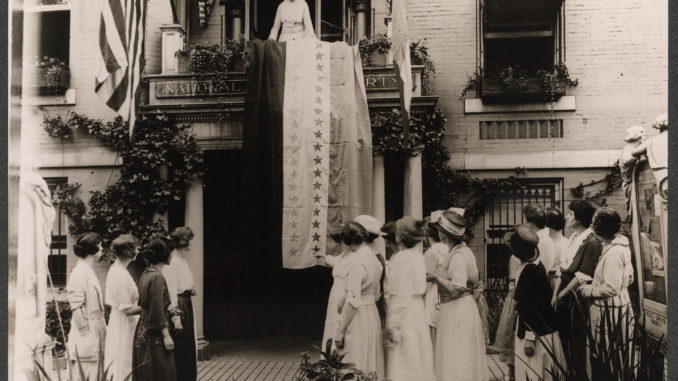
Women’s Suffrage Series
Cherry Sokoloski
Never underestimate the power of motherhood. That’s one of the takeaways from Tennessee’s ratification of the 19th Amendment in August of 1920. Tennessee was the 36th and final state to ratify the amendment, which finally gave women the right to vote, and it was a fight to the finish.
Tennessee was the last hope for suffrage in 1920, and both the pro-suffrage and anti-suffrage groups were well aware of that fact. The “antis” were not just powerful men; many women were involved in the National Association Opposed to Woman Suffrage, as well as local and state chapters. Often, upper-class women, these anti-suffragists saw women’s vote as a threat to femininity, domestic life, and motherhood.
Tennessee’s governor agreed to call a special legislative session to deal with the suffrage issue. In the hectic weeks leading up to that session, hundreds of outsiders descended upon the capital city of Nashville to lobby the legislators. A journalist described the special session as “the bitterest, bare-fisted, name-calling, back-biting session in the state’s history.” The non-stop lobbying of legislators included elaborate receptions, garden parties, and open bars.
Both pro-suffrage organizations, the National American Woman Suffrage Association and the National Woman’s Party sent lobbyists to Nashville.
Carrie Chapman Catt was in town for NAWSA, organizing lobby efforts from her hotel room. She remembered the experience this way: “Never in the history of politics has there been such a nefarious lobby as labored to block the ratification in Nashville. They appropriated our telegrams and tapped our telephones…Even if we win, we who have been here will never remember it with anything but a shudder.” Catt even accused the antis of buying votes.
Pro-suffragists worked around the clock to gather signed pledges from legislators saying they would vote to ratify the amendment. As the days wore on, however, many of these men changed their minds. When it was time to vote, neither side was confident of a win.
This chaotic conclusion to the women’s suffrage movement was dubbed the “War of the Roses.” Those supporting women’s suffrage began sporting yellow roses, while the antis wore red roses in their lapels.
Time to vote
Legislators met on Aug. 18 to vote on ratification. The Tennessee Senate had already voted in favor of the suffrage amendment earlier in August, so it was up to the House to decide the matter.
Harry Burn, age 24 and a freshman legislator in the Tennessee House, hadn’t really made up his mind, but he did wear a red rose to the special session. He represented a conservative, anti-suffrage district in the mountains of Tennessee, and he planned to run for reelection in the fall.
The speaker of the house, Seth Walker, was a staunch anti, and he first called for a vote that would table the matter until late fall, meaning that women would be unable to vote in the 1920 election. The vote was a tie, 48 to 48, with Burn voting with the antis to delay. Then, believing that the suffragists did not have the votes to win, Walker called for an immediate vote on the question.
And this is where motherhood comes in.
The roll call was alphabetical, and Burn was the seventh on the list. Against all expectations, he removed the red rose from his lapel and voted “Aye.” There was a stunned silence, and then the suffragists burst into wild applause, throwing yellow flowers into the air. Burn, meanwhile, had to hide in the attic of the statehouse to escape the furious crowds. The ratification measure passed, 49 to 47.
What prompted Burn to change sides? One major reason was a letter from his college-educated mother that he carried in his pocket that day. “Hurrah and vote for Suffrage,” she urged her son, “and don’t keep them in doubt. I’ve been watching to see how you stood but have not seen anything yet…Don’t forget to be a good boy and help Mrs. Thomas Catt.”
The next day, Burn explained his change of heart in a written statement. He gave five reasons, including the influence of his mother and also this: “I appreciated the fact that an opportunity such as seldom comes to mortal man to free seventeen million women from political slavery was mine.”
Later, when Burn went back to his hometown to visit his constituents, he brought along a bodyguard. It proved to be unnecessary, and he was elected to a second term that fall.
One might have thought that the House vote would end the dispute, but that was not the case. Opponents used all sorts of political shenanigans to challenge the vote, and a county judge even issued a five-day restraining order forbidding Governor A.H. Roberts from certifying the result. Roberts, a pro-suffragist, ignored the order and sent the certificate to Washington, D.C. on Aug. 24.
The U.S. secretary of state signed a proclamation on Aug. 26 adding the women’s suffrage amendment to the United States Constitution. And with that stroke of the pen, one-half of the population of the United States could finally participate in the nation’s democracy.
Suffragist leaders were not invited to the signing, despite its historic significance. President Woodrow Wilson did send a message of congratulations to Catt, as head of NAWSA; but he snubbed NWP leader Alice Paul, who had embarrassed him by picketing the White House and burning his speeches.
Sources: Women’s Right to Vote: America’s Suffrage Movement by Katie Marsico, 2011; Votes for Women! By Winifred Conkling, 2018.
Support Northern Colorado Journalism
Show your support for North Forty News by helping us produce more content. It's a kind and simple gesture that will help us continue to bring more content to you.
BONUS - Donors get a link in their receipt to sign up for our once-per-week instant text messaging alert. Get your e-copy of North Forty News the moment it is released!
Click to Donate